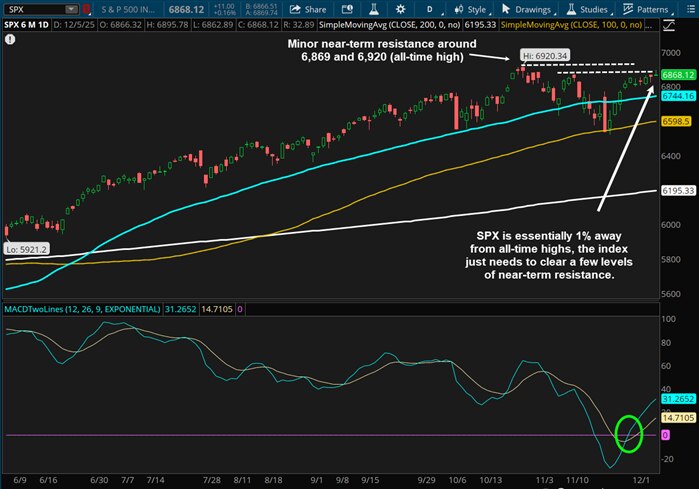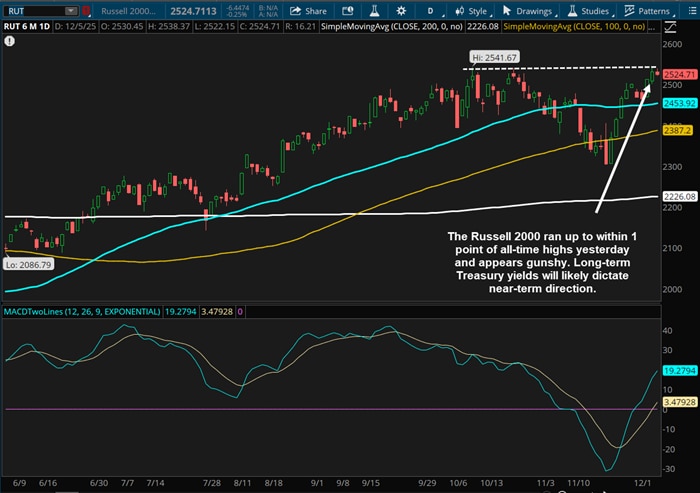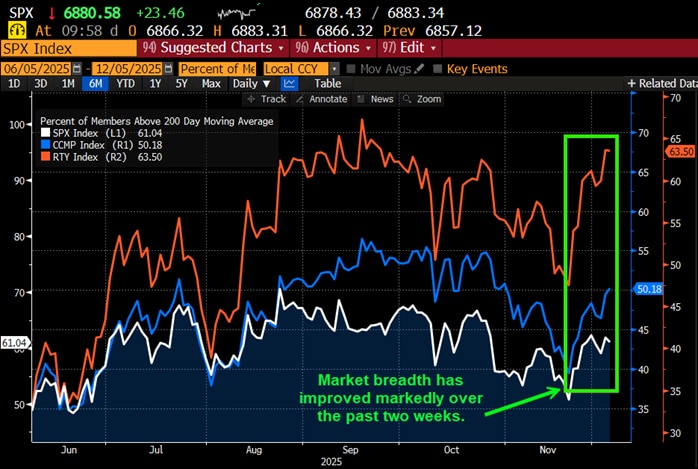Weekly Trader's Outlook
Stocks on Standby as Investors Await FOMC Meeting

The Week That Was
Last Friday we did not publish a blog due to the holiday-shortened, lower volume week, but if you read the November 21st blog, you might recall that my forecast for "Thanksgiving week" was "moderately bullish." The S&P 500 (SPX) gained 3.7% last week after the index bounced off a key intermediate-term support level at the 100-day SMA. This week the SPX has mostly been engaged in sideways consolidation, on track for a minor 0.20% weekly gain at the time of this writing. Outside of some healthy consolidation, one element that may be contributing to the muted price action is rising long-term Treasury yields. Yields on 10-year Treasuries (TNX) are up ~13 basis points this week, driven by rising JGB yields over in Japan. 10-year JGBs are up over 10 basis points this week to 1.97%, representing an 18-year high, while 30-year JGBs hit a record high of 3.43% earlier this week. The Bank of Japan (BOJ) has established a more hawkish tone, citing inflation concerns, and expectations for a rate hike at the December 18-19 BOJ monetary policy meeting have been on the rise. While it's unclear whether the ascent in JGBs will result in an unwind of the "Yen carry trade," it's apparent that it impacts the global yield environment. Another potential variable impacting long-term Treasury yields would be a dovish Federal Reserve, at least according to Bank of America strategist Michael Hartnett. Hartnett warns that if the Fed cuts rates too aggressively, it could impact longer-term inflation forecasts and result in higher long-term yields. "Only thing that can stop Santa Claus rally is a dovish Fed cut causing a selloff in long-end," Hartnett wrote in a note. The Fed's FOMC meeting is next Tuesday/Wednesday and there is currently a 95% chance that they will deliver a 25-basis-point cut, according to Bloomberg. If long-term Treasury yields continue to rise will that thwart a Santa Claus rally for stocks? In my view it will depend on the velocity of the rise, should it occur.
On the economic front, this morning's monthly PCE report delivered slightly cool inflation data (YoY core PCE up 0.1% less than expected), though the 2.8% YoY increase remains well above the Fed's target. This week's labor market data provided mixed messages as ADP reported the largest job loss (-32K) in over two years, but Initial Jobless Claims hit a three-year low (more on this in the "Economic Data, Rates & the Fed" section below).
Outlook for Next Week
At the time of this writing (2:11 p.m. ET), stocks are higher across the board, but off the highs of the session (DJI + 162, SPX + 16, COMPX + 62). Ten-year Treasury yields (TNX + 0.031 to 4.139%) are pushing up towards a two-week high, and JGBs are also higher. I feel like the trajectory of stocks next week will likely be tied at least in part to the trajectory of long-term Treasury yields. Markets are expecting a 25-basis-point cut from the Fed, but the forward guidance will likely dictate the direction of 10-year yields. I referenced Hartnett's warning against a "too dovish" Fed, but I'm not convinced that there is a high probability of that occurring. First, there have been a number of dissents within the Fed, and Powell himself said that a December rate cut is "far from" certain at the last FOMC meeting. Additionally, Powell is getting ready to step down as chairman and has a legacy to preserve and I'm not sure that he will want to be excessively dovish at this juncture. Another potential catalyst is Oracle earnings, which will be released the same day as the FOMC meeting is wrapping up (December 10th). Given the concerns around AI overinvestment and heavy debt issuance, along with Oracle's credit default swap (CDS) rising to the highest levels since 2009, I view this event as a bit binary for the AI trade, which could affect overall sentiment around stocks. Oracle could deliver strong results to help assuage investor concerns over AI spending or of course they could disappoint and sour investment sentiment. Leading up to next Wednesday, I feel that it's likely that markets remain in a "wait and see" mode, which likely means some choppy sideways price action. Therefore, my forecast for next week is "neutral" for the first half of the week and "higher volatility" for the back half. My prediction for higher volatility call is non-directional (higher or lower), as I don't know what Powell will say or what Oracle will report, I just believe the potential for a bigger move on Thursday/Friday is in the cards. What could challenge my forecast? If JGB yields turn lower and pull Treasury yields lower along with them, this could lead to a bullish first half of the week, which could set the SPX up for a test of the all-time highs.
Other Potential Market-Moving Catalysts
Economic:
- Monday (Dec. 8): -no reports-
- Tuesday (Dec. 9): JOLTS – Job Openings, Productivity – Revised, Unit Labor Costs
- Wednesday (Dec. 10): EIA Crude Oil Inventories, Employment Cost Index, FOMC Rate Decision, MBA Mortgage Applications Index, Treasury Budget, Wholesale Inventories
- Thursday (Dec/ 11): Continuing Claims, EIA Natural Gas Inventories, Initial Claims, Producer Price Index (PPI), Core PPI
- Friday (Dec. 12): -no reports-
Earnings:
Monday (Dec. 8): Compass Minerals International Inc. (CMP), Phreesia Inc. (PHR), Toll Brothers Inc. (TOL)
Tuesday (Dec. 9): AeroVironment Inc. (AVAV), AutoZone Inc. (AZO), Braze Inc. (BRZE), Campbell's Co. (CPB), Caseys General Store Inc. (CASY), Core & Main Inc. (CNM), Ferguson Enterprises Inc. (FERG), GameStop Corp. (GME), Sailpoint Inc. (SAIL)
Wednesday (Dec. 10): Adobe Inc. (ADBE), Chewy Inc. (CHWY), Daktronics Inc. (DAKT), Hello Group Inc. (MOMO), Nordson Corp. (NDSN), Oracle Corp. (ORCL), Photronics Inc. (PLAB), Synopsis Inc. (SNPS), Uranium Energy Corp. (UEC), Vail Resorts (MTN)
Thursday (Dec. 11): Broadcom Inc. (AVGO), Ciena Corp. (CIEN), Costco Wholesale Corp. (COST), Lovesac Co. (LOVE), Lululemon Athletica Inc. (LULU), Netskope Inc. (NTSK) RH Inc. (RH)
Friday (Dec. 12): Johnson Outdoors Inc. (JOUT), Zedge Inc. (ZDGE)
Economic Data, Rates & the Fed
There was a solid dose of economic data for investors to digest this week, highlighted by some mixed labor market data and the monthly reading on the Fed's preferred inflation report (PCE Prices). On the labor front, ADP reported the largest decrease in over two years (-32K) while Jobless Claims came in at a three-year low. Some have called the current environment a "no hire, no fire economy". On the inflation front, PCE Prices mostly came in-line with expectations, though the core year-over-year increase was 0.1% light. Here's the breakdown from this week's reports:
- PCE Prices: Headline PCE increased 0.3% month-over-month (MoM) and 2.8% year-over-year (YoY), both in-line with estimates. Core PCE increased 0.2% MoM (in-line with estimates) and 2.8% YoY (0.1% less than expected).
- Personal Income: +0.4% vs. +0.4% est.
- Personal Spending: +0.3% vs. +0.3% est.
- University of Michigan Consumer Sentiment: Increased 2.3 points in December to 53.3, better than the 52.2 expected. Year-ahead inflation expectations dropped to 4.1% from 4.5% in the prior month, which marks four consecutive months of declines and the lowest reading since January. Long-run inflation expectations eased to 3.2% from last month's 3.4% reading.
- ADP Employment Change: Private Payrolls fell by 32K in November, which was the largest drop since early 2023 and below the +40K expected. The bulk of the job losses came from small businesses.
- ISM Services: 52.6% vs. 52.2% est.
- ISM Manufacturing Index: 48.2% vs. 49.2% est.
- Initial Jobless Claims: Initial applications for US jobless benefits dropped to a three-year low of 191,000 for the week ending November 29th from 218,000 in the prior week and below the 221,000 economists had expected. Continuing Claims dropped to 1.939M from 1.943M in the prior week.
- EIA Crude Oil Inventories: +0.574M barrels
- EIA Natural Gas Inventories: -12 bcf
- The Atlanta Fed's GDPNow "nowcast" for Q3 GDP was revised down to 3.8% yesterday from 3.9% on December 1st, which was primarily driven by modest downward revisions in the nowcasts for both real personal consumption expenditures growth and real gross private domestic investment growth.
U.S. Treasury yields rose across the board this week and the yield curve steepened. The front end of the curve has been held down due to expectations for Fed rate cuts while the back end of the curve has lifted due to higher JPY yields as expectations for a rate hike by the BOJ have been on the rise. Compared to last Friday, two-year Treasury yields are up ~5 basis points (3.546% vs. 3.497%), 10-year yields are up ~11 basis points (4.125% vs. 4.017%) and 30-year yields also pushed higher by 11 basis points (4.782% vs. 4.665%).
Expectations for a rate cut from the Federal Reserve at next week's FOMC meeting have continued to move higher. Per Bloomberg, the probability of a 25-basis-point cut at next week's FOMC meeting currently stands at 95%, up from 83% last Friday. However, the total number of 25 bps cuts between now and the end of 2026 has moved down to 3.33 from 3.70 last Friday. Perhaps the longer-term outlook on monetary policy is being held in check until the next head of the Federal Reserve has been announced and the U.S. Supreme court rules on whether the U.S. President can remove officials from independent agencies like the Federal Reserve.
Technical Take
S&P 500 Index (SPX + 11 to 6,868)
Last time (November 21st) I wrote about how the S&P 500 index (SPX) was in the process of testing support at its 100-day Simple Moving Average (SMA), and it ended up holding up the index has rallied 4% since then. Now the index is back above its 50-day SMA, which is bullish, and is less than 1% below its all-time high of 6,920 from October 29th. Also worth noting is a bullish MACD cross back on November 26th (the green circle in the chart below). However, in the very near-term there are a few minor resistance levels at 6,868 (where the index pulled back on November 12th) and the prior all-time high (6,920). Still, the overall technical snapshot remains bullish.
Near-term technical translation: moderately bullish

Source: ThinkorSwim trading platform
Past performance is no guarantee of future results.
Russell 2000 Index (RUT - 6 to 2,524)
The Russell 2000 Index (RUT) ran up to within one point of its all-time high (2,541) yesterday and appears reluctant to decisively break out to the upside. One factor likely giving this rate-sensitive index pause is the recent ascent of long-term Treasury yields—10-year Treasury yields are up 13 basis points this week, primarily driven by rising bond yields over in Japan. Additionally, there is an FOMC meeting next week, which could lower yields on the short end of the curve, but also could lift longer-term yields, which likely won’t be conducive for the RUT. Therefore, with the index bumping heads up against near-term resistance (i.e. its prior all-time high), coupled with the potential for higher long-term Treasury yields, I put the index in the “cautious” camp at this juncture.
Technical translation: cautious

Source: ThinkorSwim trading platform
Past performance is no guarantee of future results.
Cryptocurrency News
On Wednesday Ethereum (ETH) activated its "Fusaka" upgrade, representing the blockchain's second major code change of 2025. The upgrade, which simultaneously bundles a hard fork on the consensus layer and another one on the execution layer, is designed to help the Ethereum network handle increasingly large transaction batches coming from the layer-2 networks that settle on top of it. Fusaka strengthens the underlying architecture of Ethereum and aims to lower transaction fees, improve performance (8x data throughput via PeerDAS) and scalability. The Fusaka upgrade is designed to help narrow the performance gap between Ethereum and high-speed, lower cost blockchains like Solana. ETH's price gained roughly 10% this week, which puts the coin back above the psychologically important $3,000 price level and its 200-day Simple Moving Average (SMA) of ~$3,080.
Market Breadth
The Bloomberg chart below shows the current percentage of members within the S&P 500 (SPX), Nasdaq Composite (CCMP), and Russell 2000 (RTY) that are trading above their respective 200-day Simple Moving Averages (SMA). In short, stocks have rallied over the past two weeks and market breadth has improved significantly as a result. Compared to two Fridays ago, the SPX (white line) breadth has moved up to 61.04% from 50.80%, the CCMP (blue line) has increased to 50.18% from 39.42%, and the RTY (red line) has expanded to 63.50% from 47.46%.

Source: Bloomberg L.P.
Market breadth attempts to capture individual stock participation within an overall index, which can help convey underlying strength or weakness of a move or trend. Typically, broader participation suggests healthy investor sentiment and supportive technicals. There are many data points to help convey market breadth, such as advancing vs. declining issues, percentage of stocks within an index that are above or below a longer-term moving average, or new highs vs. new lows.
This Week's Notable 52-week Highs (83 today): Apple Corp. (AAPL - $0.71 to $279.99), Citigroup Inc. (C + $1.18 to $108.97), General Motors Company (GM + $1.42 to $76.56), Intel Corp. (INTC + $2.20 to $42.69), Marriot International Inc. (MAR - $1.50 to $294.50), Walmart Inc. (WMT + $0.74 to $115.58)
This Week's Notable 52-week Lows (22 today): Autohome Inc. (ATHM + $0.08 to $23.46), Gitlab Inc. (GTLB + $0.52 to $38.03), Nutanix Inc. (NTNX + $0.91 to $48.02), Okta Inc. (OKTA - $0.05 to $85.85), SBA Communications Inc. (SBAC - $0.73 to $189.26), Stride Inc. (LRN + $1.76 to $62.78)
Get expert insights on market drivers and their potential impact to your portfolio. Join us for this Schwab Coaching special event: the 2026 Market Outlook on December 11 at 7:00 p.m. ET. Just tune in to our media affiliate Schwab NetworkTM* to see what our experts think might affect the markets next year.